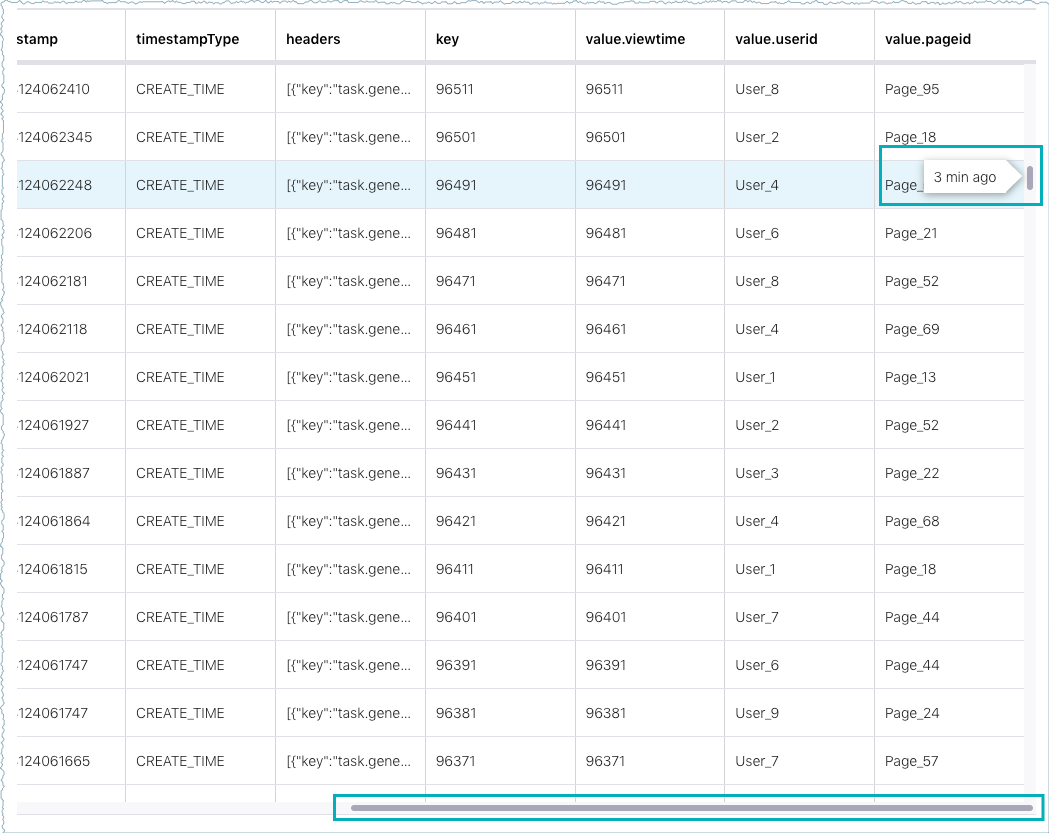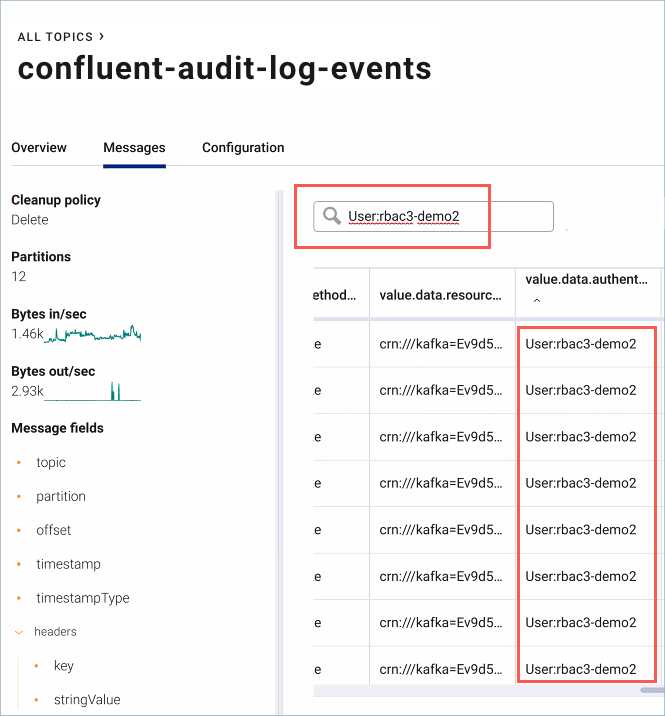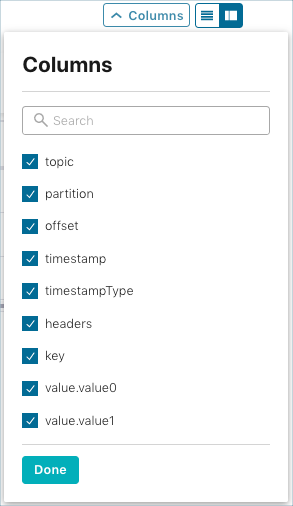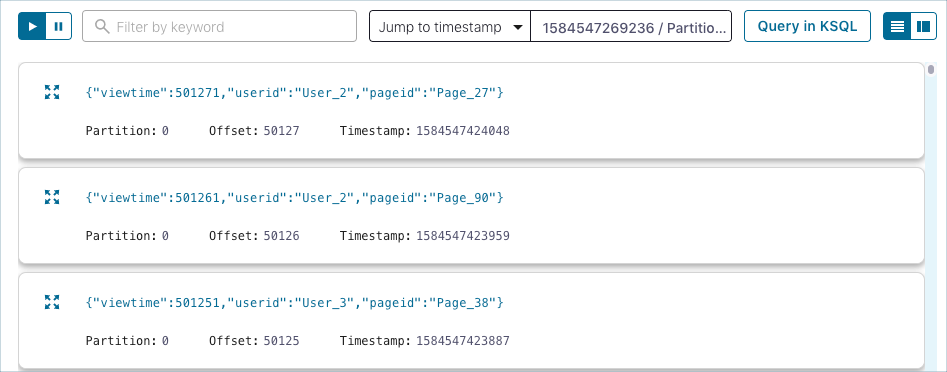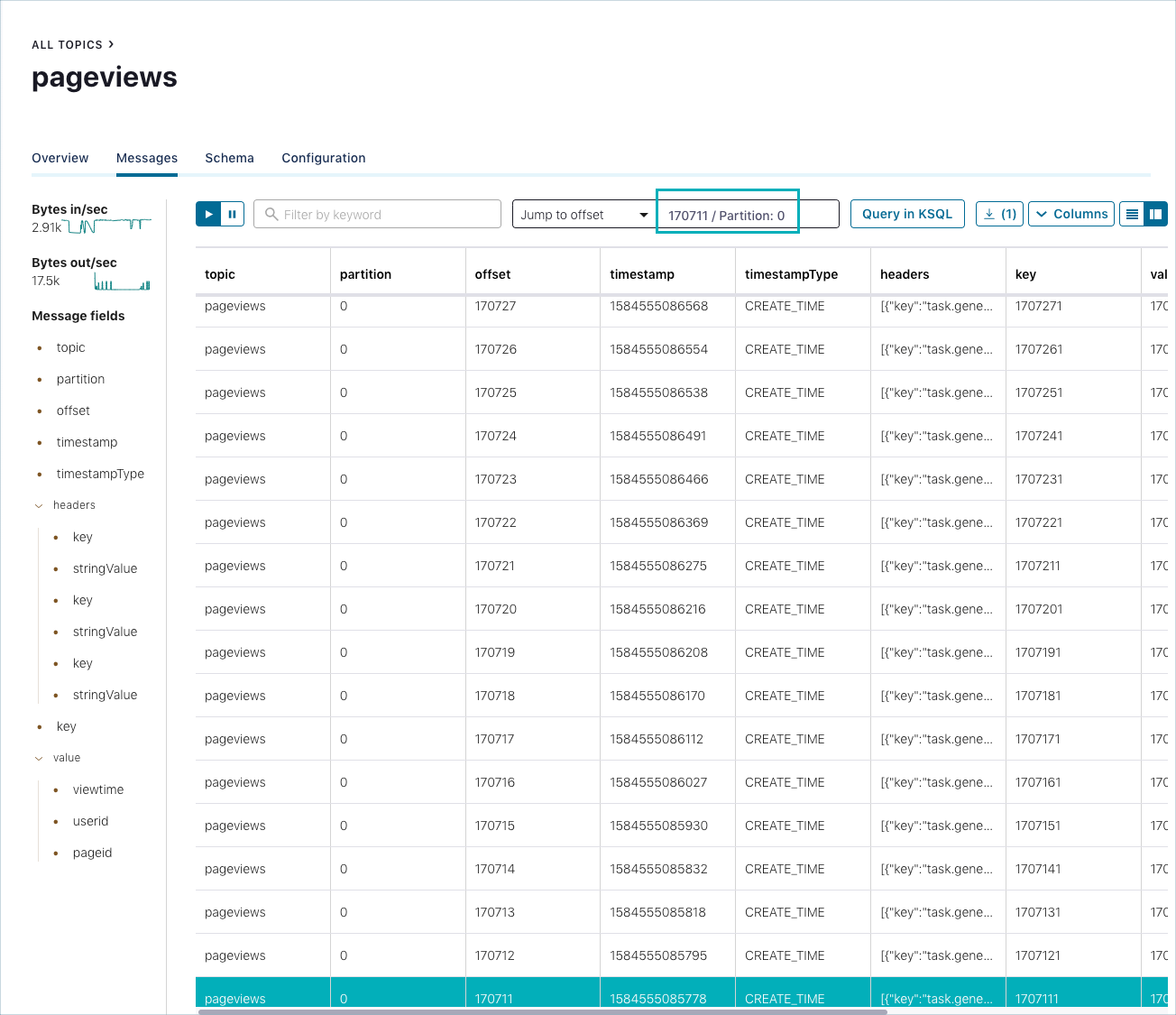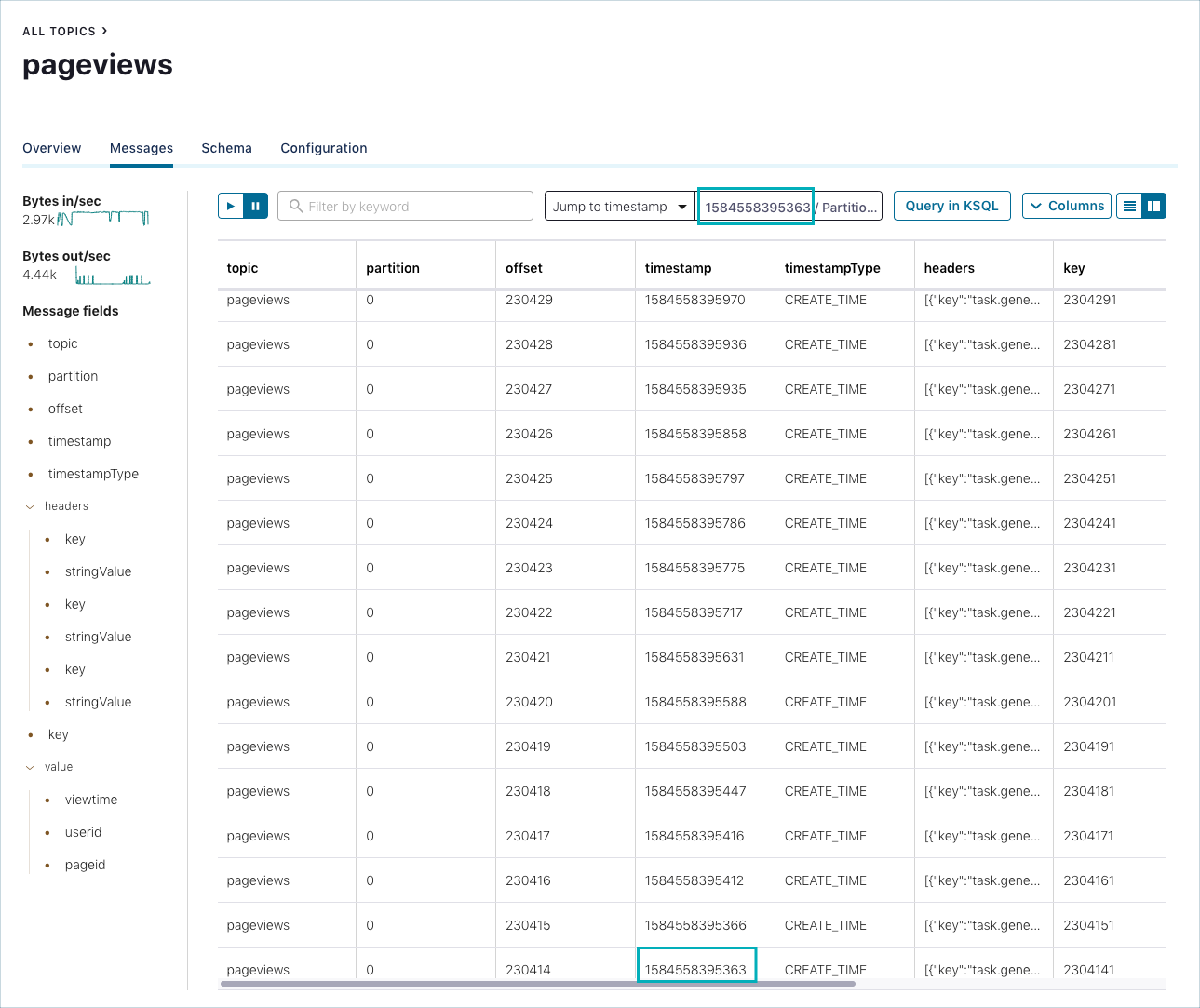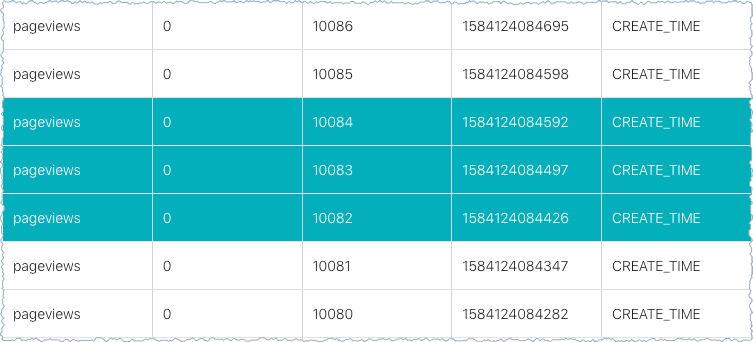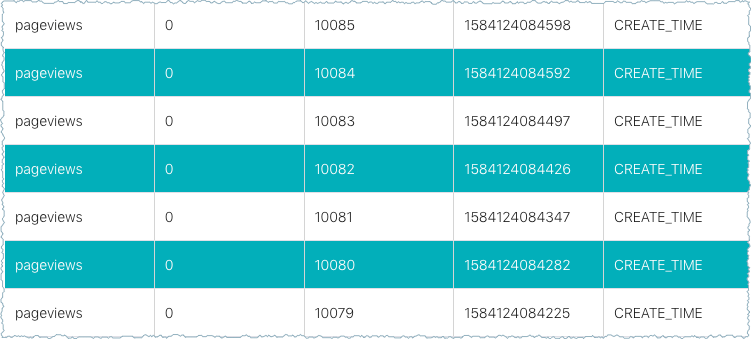Important
You are viewing documentation for an older version of Confluent Platform. For the latest, click here.
Message Browser¶
From the Messages page, you can view the data being produced to a topic. Browse message data, seek to a specific offset or timestamp by partition, and select messages you want to download.
- Prerequisites
- There must be data being produced to or already present in a topic. If you don’t already have data flowing through a topic, you can use the appropriate quick start guides to get started. You can replay old data that was already produced as long as it hasn’t been compacted or deleted yet.
Inspect a topic¶
The Topic Inspection feature in Control Center is enabled by default. With this feature, you can inspect topic details and browse live streaming messages.
To browse a live stream of messages and inspect a topic:
Select a cluster from the navigation bar and click the Topics menu. The All Topics page appears.
In the Topics table, click the topic name link.
Click the Messages tab.
To browse the messages pane:
- Click the horizontal (tabular view) and vertical scrollbars to view all of the available data. The newest data is displayed at the top of the messages pane. As you scroll vertically, or hover in the messages pane, a timeline arrow indicates when the messages were received.
To pause scrolling incoming messages so that you can analyze the data, click the pause icon. Messages may still be produced to the topic; however, the message browser does not display newly consumed data while the view is paused. Click the play icon to resume displaying incoming messages. Clicking the cards view expand icon automatically pauses the display of incoming messages.

Note
Hovering over the messages pane also holds your place for a quick glance at data. Moving the cursor focus outside of the messages pane resumes the incoming flow of messages.
To filter the results, enter the criteria in the Filter by keyword box.
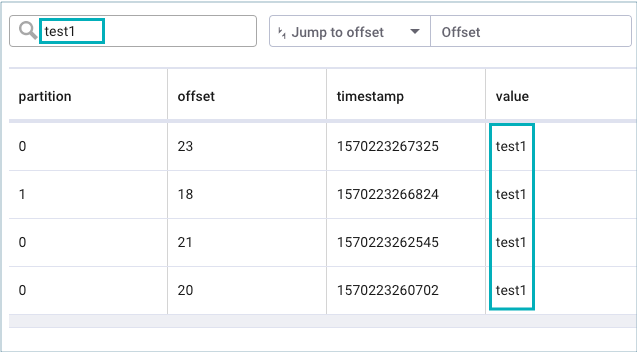
Prefix search for topic messages by keyword of value
Note
Only prefix searching is currently supported. You can search for the beginning portion of a keyword. The search keyword must be the first substring in a column item. The filter matches the search string across any of the columns.
Important
When you are searching the audit log for user activity in the message browser, you must use the format
User:<username>. To navigate to the audit log, click Cluster > Topics >confluent-audit-log-events> Messages tab.Click Query in ksqlDB to register the topic as a stream or table.
Click Columns to select which columns you want to toggle on or off in the topic messages table. There must be populated message data for the Columns selector to appear. Narrow the view to focus on the columns of interest without resorting to horizontal scrolling. If you jump to an offset or timestamp, the table resets to show all columns again. The Columns selector is not available in the Cards view; it is only applicable to the Table view.
Click the cards or table (default) icon for the layout view you prefer:

Click the expand icon
 in the cards view to access the contents of the message. Click the Value,
Header, or Key tab. Expanding the card view for a message automatically pauses the display
of incoming data. Clicking the play icon collapses the expanded cards views and resumes displaying the
incoming data.
in the cards view to access the contents of the message. Click the Value,
Header, or Key tab. Expanding the card view for a message automatically pauses the display
of incoming data. Clicking the play icon collapses the expanded cards views and resumes displaying the
incoming data.
Jump to an offset¶
To jump to a message offset, click the Jump to offset menu and enter the offset and partition. Messages are displayed in the message browser pane starting from the desired offset, and continue to feed in at the top of the message browser pane.
The record at the offset is highlighted and preselected for download.
Jump to a date and time¶
Seeking to a specified time jumps to the earliest offset where the timestamp was first recorded. Even if there are multiple data points associated with a timestamp, the seek goes to the earliest offset. Messages are displayed in the message browser pane starting from the desired time, and continue to feed in at the top of the message browser pane. Manually select any messages you want to download.
To jump to a specific date and time:
Click the Jump to time menu.
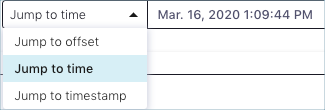
Click the default current date and time box to open a calendar.
Select a partition.
Tip
You must select a partition before trying to adjust the time or apply the new date and time.
Click a calendar date. Use the arrows to go forward or back and select a month and day.
Click the time box to adjust the time in hours, minutes, seconds, and AM or PM.
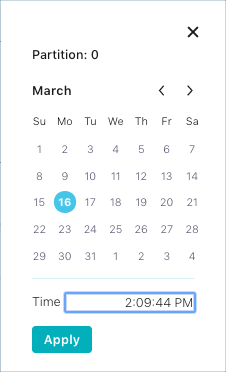
Click Apply.
Jump to a timestamp¶
To jump to a message timestamp, click the Jump to timestamp menu and enter the timestamp and partition.
The timestamp is displayed in microseconds. Enter your time of interest in milliseconds into the timestamp box and selected partition.
Tip
Use a timestamp converter to convert the timestamp into a human-readable date and time.
Seeking to a specified time jumps to the earliest offset where the timestamp was first recorded. Even if there are multiple data points associated with a timestamp, the seek goes to the earliest offset. Messages are displayed in the message browser pane starting from the desired time, and continue to feed in at the top of the message browser pane. Manually select any messages you want to download.
Download selected topic messages¶
Download selected rows of messages in a JSON format. When you jump to an offset, date/time, or timestamp, the record at the offset is highlighted and preselected for download. You can download messages from the Messages browser in Topics or ksqlDB.
Select one or more contiguous or non-contiguous rows. The download button becomes available and shows the number of selected messages.
Tip
Press the command key + click to select non-contiguous rows. Press shift + click on a beginning and ending row to select a contiguous range of messages.
Click the download icon. A file named
selected_data_n.jsonthat contains the selected messages in JSON format is downloaded into your downloads directory. The n represents the number of selected messages.Example filename:
selected_data_3.jsonExample contents:
[{"topic":"pageviews","partition":0,"offset":238156,"timestamp":1561686540691,"timestampType":"CREATE_TIME","headers":[],"key":"2364041","value":{"viewtime":2364041,"userid":"User_3","pageid":"Page_25"}},{"topic":"pageviews","partition":0,"offset":238155,"timestamp":1561686540662,"timestampType":"CREATE_TIME","headers":[],"key":"2364031","value":{"viewtime":2364031,"userid":"User_1","pageid":"Page_12"}},{"topic":"pageviews","partition":0,"offset":238154,"timestamp":1561686540593,"timestampType":"CREATE_TIME","headers":[],"key":"2364021","value":{"viewtime":2364021,"userid":"User_4","pageid":"Page_21"}}]
Enable and disable topic inspection (message browsing) in Control Center¶
The topic inspection feature is enabled by default in Control Center. The feature can be disabled if an organization does not want any users to access the feature. After disabling the feature, the Inspect menu and the Inspect tab are no longer visible in the Control Center UI.
To disable the inspect topic feature in Control Center:
Set the
confluent.controlcenter.topic.inspection.enableoption in yourcontrol-center.propertiesfile tofalse.... confluent.controlcenter.topic.inspection.enable=false ...
Note
Make the change in the appropriate Control Center properties file or files configured for your environments, including
control-center-dev.propertiesorcontrol-center-production.properties. The properties files are located in/path-to-confluent/etc/confluent-control-center/. For more informatin, see Control Center properties files.Restart Control Center and pass in the properties file for the configuration to take effect:
./bin/control-center-stop ./bin/control-center-start ../etc/confluent-control-center/control-center.propertiesTip
If you are using a Confluent Platform development environment with a Confluent CLI, stop and start as follows:
./confluent local stop control-center ./confluent local start control-center ../etc/confluent-control-center/control-center-dev.properties
To enable the feature again, set the option back to true and restart
Control Center with the updated properties file.
For more information about restarting Control Center and passing in its properties files, see Control Center properties files.

